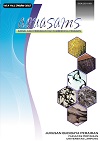PERFOMANCE GROWTH AND SURVIVAL RATE OF CATFISH HATCHED LARVAEA IN MASS CULTURED WITH THE PROVISION OF FEED Tubifex sp USING FERMENTED INDUSTRIAL DOMESTIC WASTE
Abstract
Tubifex sp. merupakan salah satu pakan alami terbaik untuk larva lele. Kultur massal Tubifex sp .perlu dilakukan untuk mencukupi kebutuhan pakan lele secara kuantitas maupun kualitas khususnya pada stadia larva. Tujuan dari penelitian adalah mengkaji performa pertumbuhan dan kelulushidupan larva lele dengan pemberian pakan Tubifex sp. yang dikultur massal menggunakan fermentasi limbah industri rumah tangga. Hewan uji yang digunakan adalah larva ikan lele (C. gariepenus) dengan berat0,06±0,03 g/individu. Penelitian ini dilakukan dengan metode eksperimental menggunakan rancangan acak lengkap (RAL) dengan 3 kali ulangan yaitu perlakuan A (50 g/L kotoran ayam; 100g/Lroti afkir; 50 g/L ampas tahu); B (50 g/L kotoran ayam; 100g/L bekatul; 50 g/L ampas tahu) dan C (50 g/L kotoran ayam; 100g/L bungkil kelapa; 50 g/L ampas tahu). Pemberian Tubifex sp. sebagai pakan alami sebanyak 5 kali sehari secara ad libitum.Hasil penelitian menunjukkan bahwa terjadi pengaruh yang nyata (P<0,01) pada laju pertumbuhan dan tidak berpengaruh yang nyata (P>0,01) kelulushidupan larva ikan lele(C. gariepenus). Laju pertumbuhan relatif larva ikan lele (C. gariepenus) memiliki nilai rerata berkisar antara 17.1%-18.7% dengan tingkat kelulushidupan berkisar antara 96,8% - 98,8%. Berdasarkan pada hasil penelitian, maka perlakuan A dengan nilai RGR dan SR 18.7% dan 98.8% merupakan perlakuan terbaik untuk meningkatkan laju pertumbuhan dan kelulushidupan larva ikan lele (C. gariepenus).

.png)










